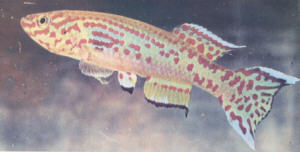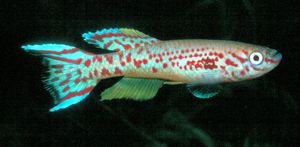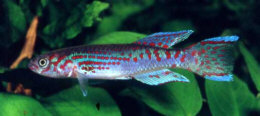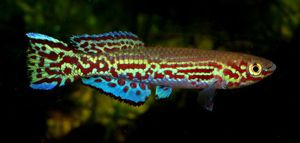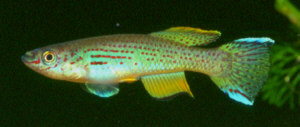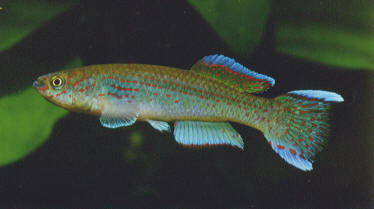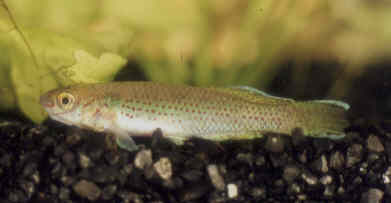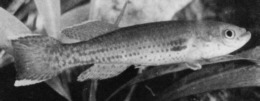Fundulopanchax lacustris (Radda 1974)
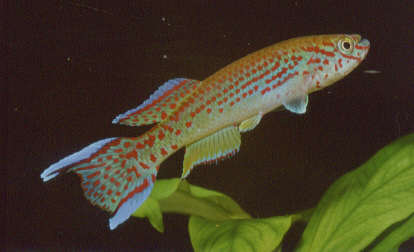
Lake Ejagham. Photo courtesy of Ed Pürzl.
| Meaning of Name |
After lacustris meaning to come from the lake (Ejagham). | |||||||||||||||
| First Description |
Radda A.C. 1974 (Aphyosemion gardneri lacustre). Studien zur Cytogenetik, Taxonomie und Verbreitung der 'Gardneri-Gruppe' der Gattung Aphyosemion (Osteichthyes: Cyprinodontidae) aus dem südlichen Westkamerun. Jahrbuch des Naturhistorisches Museum der Stadt Bern 5: p 4-6. figure 1B, 3. | |||||||||||||||
| Size |
54 mm (according to first description). | |||||||||||||||
| Meristics |
D = 15-16, A = 15-17, D/A = +3-4, ll = 31-32 +2-3 (Radda 1974) | |||||||||||||||
| Karyotype |
| |||||||||||||||
| Sub-Genus |
Paraphyosemion | |||||||||||||||
| Group |
gardneri | |||||||||||||||
| Synonyms |
| |||||||||||||||
Populations
The populations - All populations listed here are in a small nest of locations within the Munaya drainage. |
Lake Ejagham - Lake Ejagham
is situated just south of Eymojok. It is treated by local peoples
as a sacred lake supposed to be haunted by the ghosts of past ancestors.
It lies at the centre of 13 salt springs. Ejagham is split into 3
words - “Ekub” (a whole or parcel), “Ejag” (is
split or broken), ‘ Haam” (is infinite or without end).
Basically refers to a splitting of the local tribe which is striving
for reunification.
C 89 / 5 - Collected by Wolfgang Eberl, Oliver Legros & Bas Vlijm, July 1989 in a stream found by walking through an experimental plantation & along a hard to follow trail for 500 metres. Ten pairs of young fish were collected. Other fish found were cichlids & barbs.
HAH 98 - Lake Ejagham
Radda's 1970's Collections - These photos represent Radda's original fish. Few & small spots, blue phase & a distinctive anal fin with a dark red outer margin.
| |||||||||||||||
| Type Locality |
An outlet of Lake Ejagham near Eyoumojok in the Ossidinge area.They were found in small pools of a drying tributary. | |||||||||||||||
| Distribution |
Restricted to the area of Lake Ejagham, western Cameroon ???. Click link to map of gardneri distribution. This comprises all populations I can find on maps. You can zoom in but markers are not accurate to the exact collection spot, just the area which builds up a picture of distribution. map The single stream from Lake Ejagham drains towards
Eyumojok. Around here maps do not show the stream continuing far outside
the village. Eyumojok is likely to drain into the Munaya river which
is where Akaram
is located (Akwen
also drains into this river). Akaram has been distributed as lacustris
& it may be that Lake Ejagham, Eyumojok, Akaram & possibly Akwen
are all part of lacustris. | |||||||||||||||
| Habitat |
Small pools, streams & brooks originating
from a single outlet from Lake Ejagham. Some of these pools are most
likely to be seasonal. | |||||||||||||||
| Distinguishing Characteristics | Easily
distinguished from other gardneri
forms. The basic body colouration is green. The red spots on the body
are small & are arranged in broken lines. This is perhaps the least
colourful of all gardneri forms. In Wildekamp's book 'Wold of Killies' he remarked the top caudal extension was longer than the lower extension. |
|||||||||||||||
| Colour/Pattern Variability | Not
as high as some of the other gardneri
subspecies but their is variability between different collection dates. Scheel in ROTOW II described the anal fin as being greenish yellow to orange which may exhibit a row of small red spots in the basal area. The anal fin seems to be a strong identifier with an outer marginal band of dark red. Some fish also exhibit a row of small red spots horizontally midway through this fin. |
|||||||||||||||
| History |
Found in 1970 by A.C.Radda & Walter Haefelin
in pools of a drying outlet of Lake Ejagham.
They also collected at Eyumojok. | |||||||||||||||
| Breeding Notes |
This
is perhaps the most difficult of all the gardneri
sub-species to breed. Some reports suggest that this type is best spawned in cool
water while others suggest that they only spawn at certain times of the year.
I must admit defeat with this one, having tried many years ago. All attempts to
spawn them ended in defeat & I decided to pass them on to a fellow killie
keeper to see if they would do better in his water. They are regarded as more of an annual than most 'gardneri' with eggs taking 4 weeks of semi-dry storage to hatch. Fred Wright observed that most of those hatching in this period were observed to be males in BKA newsletter No.100, December 1973. It was noted that if this peat was left submerged in water for a further period the hatching fry turned out to be mostly females. Alan Green bred this subsp. in the '80's in 2' (60 cm) deep tanks but had few eggs. Water temperature approx. 73°F. | |||||||||||||||
| Diameter of Egg | 1.3 / 1·4mm | |||||||||||||||
| Remarks |
Lake Ejagham is an isolated biotope with no feeder streams & only one output stream. This stream is where Radda & the C89 collections were made. It's interesting as the Radda collections of 1970 appear different, being very bland looking with little colour & a green overcast. The C89 collection seems more colourful with more red spots. The closest village to the lake is Eyumojok. From here the road east passes through the collection sites from Akwen & Akaram. I think lacustris
is an interesting sub species. Generally thought of as just coming from
an outlet from Lake Ejagham. The outer marginal dark red band in the
anal fin is also present in the Eyumojok population which is further
downstream in the stream coming from the lake. |
